- There is more to India than the Golden
Triangle. Article suggest 5 regions that should be promoted and has a To Do
List for Central & state governments.
For decades we were told about the Golden Triangle consisting of Delhi, Agra and Jaipur. It has come to a stage where one feels these are India’s best and only tourist destinations. Actually, there is a lot more to India.
This article suggest five regions that
must be promoted aggressively. Some destinations are in backward areas. Tourism
will promote employment, enhance incomes and development of the region.
The first such region is Gwalior, Orchha (UNESCO
recently declared
both as World Heritage Cities), Khajuraho and Jhansi.
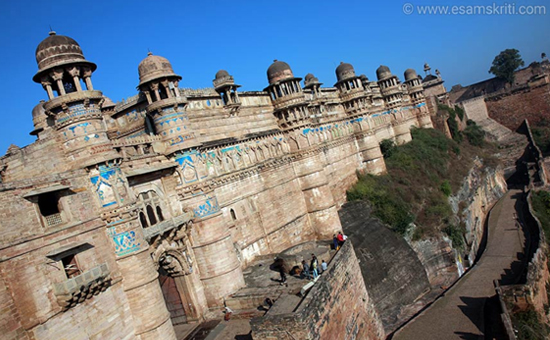 Gwalior Fort.
Gwalior Fort.
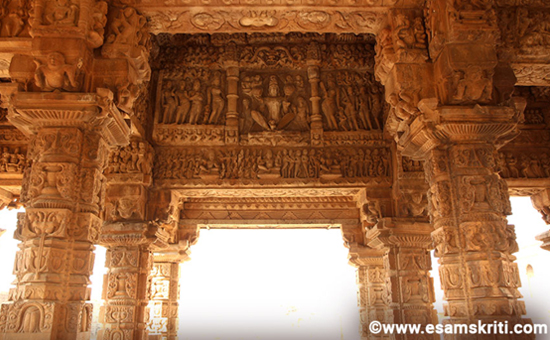 Padavali Temple, Morena.
Padavali Temple, Morena.
Gwalior is under explored and could be a base
for visiting not only Orchha and Khajuraho but also Jhansi, Dholpur (Chambal
ravines) and Morena Temples.
Gwalior is connected by air and train with
good places to stay. Currently, only one airline flies into Gwalior. Need more.
It has lots to see for eg Gwalior
Fort, Jai
Vilas Palace Museum, Rock-Cut
Jain Colossi and Sas
Bahu Temple (architectural marvel). Morena has three temples namely Bateshwar
(restored by ASI team headed by Prof K K Muhammad), Chausath
Yogini (whose round shape is believed to have inspired Parliament
design) and Padavali
(sculptures are a masterpiece).
 Datia Palace.
Datia Palace.
Enroute from Gwalior to Jhansi is the 7
storied palace
at Datia. For the devout Datia has a Shaktipeeth and Jain Temples. Close by is
the Jhansi Fort, immortalized by the Rani of Jhansi.
About 19 kms from Jhansi is the heritage
town of Orchha.
It is known for its Chhatris (cenotaphs), sun-set and Raj/Jahangir Mahal. If
there is water one can go river rafting in river Betwa on whose banks Orchha
is. For the devout there is Ram Raja Temple (here Ram is worshipped as King)
and Chaturbhuj Temple. Bundela
style Paintings inside the fort and Lakshmi Narayan Temple are worth
seeing.
It has hotels catering to various price
points. Town is very clean.
Jhansi is well connected by train. It is an overnight journey from Mumbai if one takes the Delhi Rajdhani Express from C.S.T. Wish the train stopped at Gwalior–would give a fillip to tourism. Similarly, the Shatabdi Express from Delhi to Bhopal stops at Jhansi.
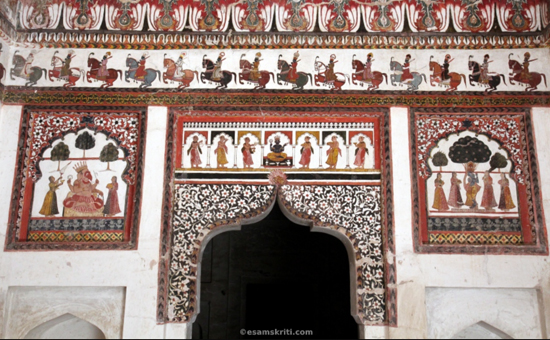 Bundela Paintings, Orchha.
Bundela Paintings, Orchha.
Jhansi to Khajuraho is 175 kms. I am told that
work on making the existing road to a four lane one is in progress. The temples
of Khajuraho do not need any elaboration.
Khajuraho to Gwalior is a longish drive at
280 kms. Wish there is a direct 4 lane highway
connecting the two.
Orchha, Khajuraho and Jhansi are in
Bundelkhand, under-developed parts of the region. More tourists will increase economic
activity. It could also motivate sellers of world famous Chanderi (app 122 kms
away) saris to open shops in Orchha. Close to Khajuraho is the Panna Wildlife
Park and 175 kms away is the pilgrimage town of Chitrakoot, both attractive
destinations.
Madhya Pradesh Tourism has good hotel
accommodation in each location, barring Jhansi where Uttar Pradesh Tourism have
their hotel.
What is missing in an aggressive marketing promotion for the region? MP Tourism must start conducted tours out of Gwalior.
This shall attract travelers who want safety and find it too expensive to cover
each location alone. For packaged tours MP Tourism could seek guidance from
Tamil Nadu Tourism who have been running tours for years.
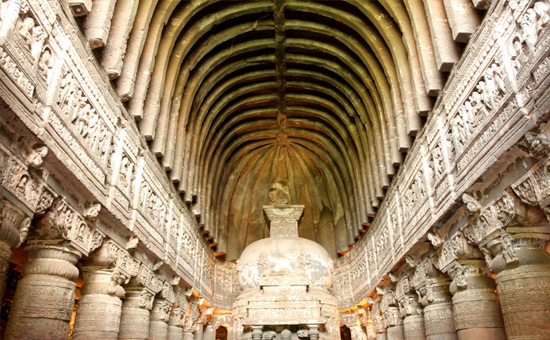 Ajanta Caves.
Ajanta Caves.
The second region that needs to be
promoted is Ajanta and Ellora. Both are located in the backward Marathwada
region of Maharashtra. There is nothing in the world like this. Aurangabad is
the base town to visit them.
Ajanta has
only Buddhist Caves (29) whilst Ellora has 34 caves of
which 17 are Hindu, 12 Buddhist and 5 Jain. Of these the most
known is Kailasa.
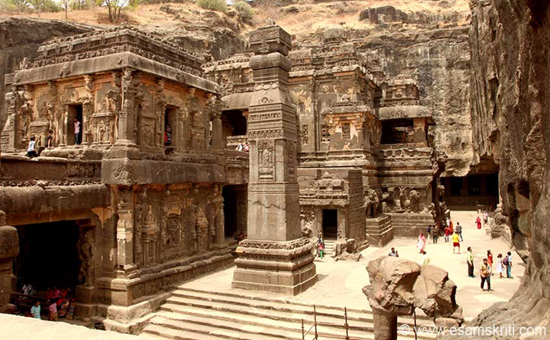 Kailasa Temple, Ellora
Kailasa Temple, Ellora
Kailasa
Temple Ellora is a single rock complex which was carved
from top to the bottom. The temple complex is “83 metres long, 46 m wide and 33 m deep.” It was excavated by cutting
away more than 50 million tons of rock from the sloping hill.
The Centre can help by making a 4 lane highway from Aurangabad to Ellora
(31 kms) and Ajanta (95 kms).
The third region for promotion is Konark
in Odisha. Tourists who visit Konark can also see Bhubaneshwar, Ratnagiri
Monastery, Peace Stupa besides buying handicrafts from Pipli ie enroute.
 Ratnagiri Monastery near Bhubaneshwar.
Ratnagiri Monastery near Bhubaneshwar.
The Sun Temple
at Konark was conceived as chariot with 12 pairs of wheels drawn by 7 galloping
horses, all carved from stone. The 12 wheels represent 12 months of the year.
The chariot (7 horses) represents 7 days of the week n 24 hours of the day in
its concept.
The Centre can help by making the entire Bhubaneshwar Konarak highway 4 lane.
 Bahubali Pranams.
Bahubali Pranams.
The fourth region to be promoted are Belur
(Chennakeshava Temple) and Halebidu
in Karnataka. Belur is 220 kms from Bengaluru. Enroute worth seeing is Bahubali
Gomateshwara at Sravanabelgola.
The Belur temple is used making soft
soapstone with very intricate carvings. Temples are worth seeing. In particular
the Belur temple is known for sculptures of ladies, on its external wall, called
Madanikas.
 Madanikas - Lady seeing herself in the mirror.
Madanikas - Lady seeing herself in the mirror.
Bengaluru is well connected across India.
Karnataka Tourism runs
conducted tours already from Bengaluru.
 Gopuram Srirangam Temple, Trichy
Gopuram Srirangam Temple, Trichy
The fifth region to be promoted are Trichy
and Thanjavur in Tamil Nadu.
Tourists can see India’s biggest temples namely Sri
Rangam Trichy, Brihadesvara Thanjavur (Tanjore) and Gangai
kondacholapuram (height of 182 feet) and Maratha Palace in Tanjore.
The Big Temple Tanjore is built out of
granite, the vimana tower above the sanctum is one
of the tallest (60.96 metres). On top of Vimana is a Stone Sikhara that weighs
81 tons. It is still a mystery on how it was carried to such height.
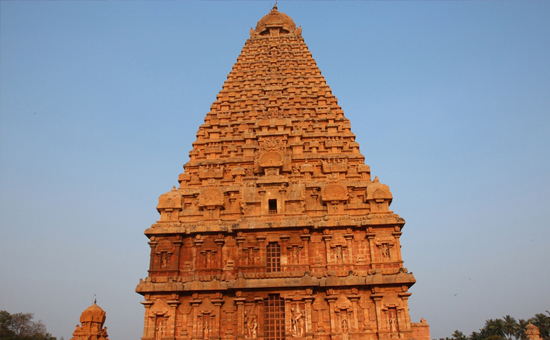 Vimana, Big Temple.
Vimana, Big Temple.
The distance between Trichy and Tanjore is
57 kms. Trichy is well connected.
Simply put, the Central and state
governments must promote these five regions. This shall introduce the world and Indians to
India besides promoting development of backward / under promoted regions.
Broadly speaking the Centre should focus
on improving connectivity (highway/air/rail) and promotion with state governments
doing the rest.